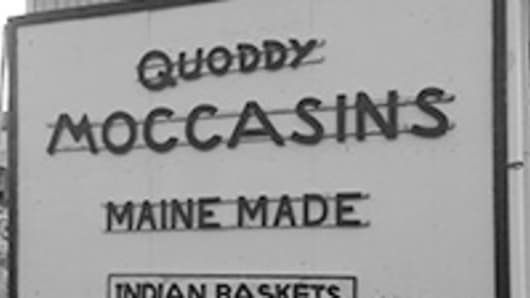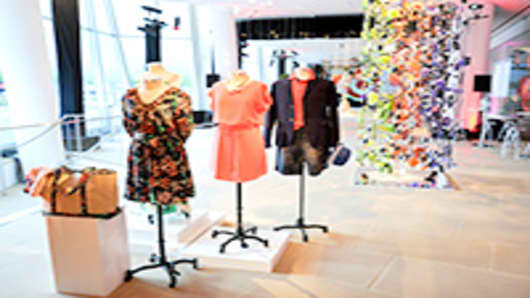If you drive up the East Coast long enough, you’ll find the little town of Perry, Maine. Nine hundred forty-three people call it home, and it’s a place where you’re just as likely to see a moose as you are a neighbor. Right off Route 1, across from the New Friendly Restaurant, sits the Quoddy Wigwam—world headquarters of Quoddy Inc.
Quoddy makes shoes, and they’ve been doing it the same way for more than 100 years: by hand, with a piece or two of leather, hand-stitched with a flexible sole.
“The people, the machines, the special shoe lathes just for moccasin construction, the suppliers — the only place we can do it is here,” Quoddy President John Andreliunas said. “How we make stuff defines who we are. And where we make stuff defines who we are.”
Almost 600 miles away, in New York, Quoddy shoes are stocked on the shelves of J.Crew store in Rockefeller Center—and in Chicago—and even across the country in Los Angeles. They’re also sold on J.Crew’s website and in the 40 million catalogs it prints every year.
“They helped legitimize us as one of the premiere heritage brands in the U.S.,” Andreliunas said. “You can’t put a price or a figure on that.”
Quoddy is just one of more than 100 brands that have partnered with J.Crew to create products for the specialty retailer. It began, like many partnerships, with a little bit of luck. Jenna Lyons, J.Crew’s president and executive creative director, happened to come across a pair of Quoddy’s sheepskin-lined ring boots in a store in New York.
“It was serendipity,” said Andreliunas. “She just got in touch with me out of the blue.”
The timing couldn’t have been better. J.Crew was ramping up “In Good Company,” a collection composed solely of partnerships with outside brands handpicked by its design team. Started in 2007, “In Good Company” brands range from the well-known — like Sperry and Timex — to heritage products, like Red Wing shoes and Barbour jackets — to the up-and-coming lines like Nili Lotan and Edith A. Miller.
“[It] makes it more interesting to the customer,” J.Crew CEO Mickey Drexler said. “How do we ever do a Nike or a New Balance vintage sneaker that’s unique and special? Or a Crockett and Jones from England? People love it.”
But retail analyst Eric Beder says bringing in outside brands goes against traditional specialty retailer thinking.
“I think it’s part ego,” said Beder, a managing director at Brean Murray, Carret & Co. “It just isn’t really done. I think the thought process is that our customer is coming in for us, for this brand. I think for J.Crew they’re coming in for a lifestyle — that’s the difference.”
Ego or not, there are a steady stream of retailers from H&M to Levis forging partnerships with outside brands and designers. Some of the most high profile collaborations have come from the aisles of Target , where the company has been partnering with designers since 1999.
“It’s all about differentiation,” Target spokeswoman Jessica Carlson said. “We’re really looking to find and bring guests that affordable, accessible design that sets us apart from the competition.”
That accessible design can turn quite a profit. In August 2003, Target debuted its collaboration with Isaac Mizrahi. According to The New York Times, it earned up to $300 million a year —raking in as much as $1.5 billion during its five-year run.
Last fall, Target struck gold again, launching a high-low collection with Italian fashion house Missoni of 400 limited-edition items across the store. It was so popular, the website crashed in a matter of hours, and shelves were empty within minutes of the doors opening. It was, in short, a media sensation — which was exactly the point, said Erin Armendinger, managing director of the Jay H. Baker Retailing Center at The Wharton School, University of Pennsylvania.
“That’s about making a splash,” she said. “You walk into the store when one of these huge rollouts is going on and they strategically place merchandise all around the store. They’re more to drive traffic, to drive media, to drive attention.”
Earlier this month, Target launched a new variation on its typical partnership: “The Shops at Target,” which, similar to the J.Crew model, focuses on curating and partners the chain with small boutiques and specialty shops. However, while Target’s will last a few weeks, J.Crew partners with brands for years.
“It’s really nice to deal with small, creative companies who sometimes don’t get an easy shot selling other stores,” Drexler said, “especially big stores who might not nurture them the way we would. And we’re not usually their biggest business, but we’re a nice part of their business.”
For Quoddy, J.Crew is its biggest business — it has tripled its sales over the past three years, which Andreliunas says is in large part due to the partnership.
With collaborations, smaller brands such as Quoddy gain advantages like exposure and a wider distribution. However, partnership collections aren’t without risks, and their success is up for debate; most companies don’t break out their numbers to account for collaborations.
“I’m sure if you look through the cemetery of partnerships, you would find many, many, many.” Armendinger said. “Look at GO International at Target. It was an incredibly successful program for a really long time until it wasn’t. The customer got used to the idea.”
“It’s not a simple equation for any of our design partnerships,” said Target’s Carlson. “It’s about looking at what’s hot, what’s on trend, what we think our guest is going to want next.”
Distribution can also be tricky when larger retailers work with smaller ones, according to Andreliunas.
“I always say you don’t really understand Quoddy until you actually come up and walk in here,” he said. “Mickey [Drexler] knows what we’re about because he’s been here. They make an effort to realize they’re dealing with smaller companies that don’t have endless supplies of people and resources and cash.”
Like a good marriage, partnerships have to work for both parties.
“People like that — they like our outside designers,” Drexler said. “If it’s exciting, if it’s good, and if it makes our customers more excited to shop with us, we’re going to do that. And also, it’s fun."





